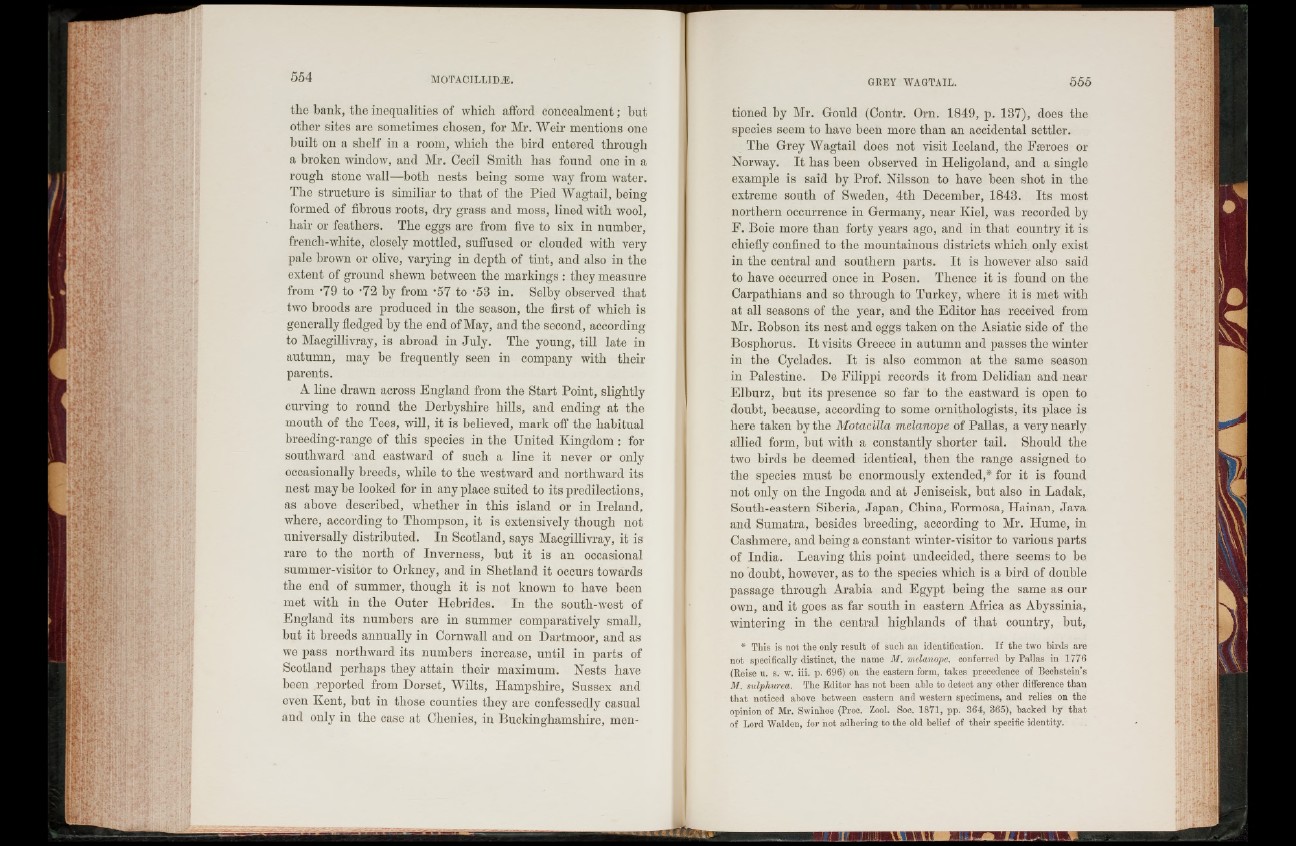
the bank, the inequalities of which afford concealment; hut
other sites are sometimes chosen, for Mr. Weir mentions one
built on a shelf in a room, which the bird entered through
a broken window, and Mr. Cecil Smith has found one in a
rough stone wall—both nests being some way from water.
The structure is similiar to that of the Pied Wagtail, being
formed of fibrous roots, dry grass and moss, lined with wool,
hair or feathers. The eggs are from five to six in number,
frencli-white, closely mottled, suffused or clouded with very
pale brown or olive, varying in depth of tint, and also in the
extent of ground shewn between the markings : they measure
from *79 to -72 by from '51 to '53 in. Selby observed that
two broods are produced in the season, the first of which is
generally fledged by the end of May, and the second, according
to Macgillivray, is abroad in July. The young, till late in
autumn, may be frequently seen in company with their
parents.
A line drawn across England from the Start Point, slightly
curving to round the Derbyshire hills, and ending at the
mouth of the Tees, will, it is believed, mark off the habitual
breeding-range of this species in the United Kingdom : for
southward and eastward of such a line it never or only
occasionally breeds, while to the westward and northward its
nest may be looked for in any place suited to its predilections,
as above described, whether in this island or in Ireland,
where, according to Thompson, it is extensively though not
universally distributed. In Scotland, says Macgillivray, it is
rare to the north of Inverness, but it is an occasional
summer-visitor to Orkney, and in Shetland it occurs towards
the end of summer, though it is not known to have been
met with in the Outer Hebrides. In the south-west of
England its numbers are in summer comparatively small,
but it breeds annually in Cornwall and on Dartmoor, and as
we pass northward its numbers increase, until in parts of
Scotland perhaps they attain their maximum. Nests have
been reported from Dorset, Wilts, Hampshire, Sussex and
even Kent, but in those counties they are confessedly casual
and only iii the case at Chenies, in Buckinghamshire, meutioned
by Mr. Gould (Contr. Orn. 1849, p. 137), does the
species seem to have been more than an accidental settler.
The Grey Wagtail does not visit Iceland, the Faeroes or
Norway. It has been observed in Heligoland, and a single
example is said by Prof. Nilsson to have been shot in the
extreme south of Sweden, 4th December, 1843. Its most
northern occurrence in Germany, near Kiel, was recorded by
F. Boie more than forty years ago, and in that country it is
chiefly confined to the mountainous districts which only exist
in the central and southern parts. It is however also said
to have occurred once in Posen. Thence it is found on the
Carpathians and so through to Turkey, where it is met with
at all seasons of the year, and the Editor has received from
Mr. Bobson its nest and eggs taken on the Asiatic side of the
Bosphorus. I t visits Greece in autumn and passes the winter
in the Cyclades. It is also common at the same season
in Palestine. De Filippi records it from Delidian and near
Elburz, but its presence so far to the eastward is open to
doubt, because, according to some ornithologists, its place is
here taken by the Motacilla melanope of Pallas, a very nearly
allied form, but with a constantly shorter tail. Should the
two birds be deemed identical, then the range assigned to
the species must be enormously extended,* for it is found
not only on the Ingoda and at Jeniseisk, hut also in Ladak,
South-eastern Siberia, Japan, China, Formosa, Hainan, Java
and Sumatra, besides breeding, according to Mr. Hume, in
Cashmere, and being a constant winter-visitor to various parts
of India. Leaving this point undecided, there seems to be
no doubt, however, as to the species which is a bird of double
passage through Arabia and Egypt being the same as our
own, and it goes as far south in eastern Africa as Abyssinia,
wintering in the central highlands of that country, but,
* This is not the only result of such an identification. If the two birds are
not specifically distinct, the name M. melanope, conferred by Pallas in 1776
(Reise u. s. w. iii. p. 696) on the eastern form, takes precedence of Bechstein’s
M. sulphured. The Editor has not been able to detect any other difference than
that noticed above between eastern and western specimens, and relies o n the
opinion of Mr. Swinlioe (Proc. Zool. Soc. 1871, pp. 364, 365), backed by that
of Lord Walden, for not adhering to the old belief of their specific identity.